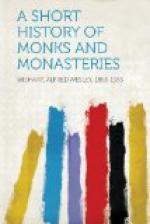Society was divided into three classes. It is computed that one-half the population were slaves. A large majority of the remainder were paupers, living on public charity, and constituting a festering sore that threatened the life of the social organism. The rich, who were relatively few, squandered princely incomes in a single night, and exhausted their imaginations devising new and expensive forms of sensuous pleasure. The profligacy of the nobles almost surpasses credibility, so that trustworthy descriptions read like works of fiction. Farrar says: “A whole population might be trembling lest they should be starved by the delay of an Alexandrian corn ship, while the upper classes were squandering a fortune at a single banquet, drinking out of myrrhine and jeweled vases worth hundreds of pounds, and feasting on the brains of peacocks and the tongues of nightingales.” The frivolity of the social and political leaders of Rome, the insane thirst for lust and luxury, the absence of seriousness in the face of frightful, impending ruin, almost justify the epigram of Silvianus, “Rome was laughing when she died.”
“On that hard
pagan world disgust
And secret loathing
fell;
Deep weariness and sated
lust
Made human life a hell.
In his cool hall, with
haggard eyes,
The Roman noble lay;
He drove abroad in furious
guise
Along the Appian Way;
He made a feast, drank
fierce and fast,
And crowned his hair
with flowers
No easier nor no guicker
past
The impracticable hours.”
Pagan mythology and Pagan philosophy were powerless to resist this downward tendency. Although Christianity had become the state religion, it was itself in great danger of yielding to the decay that prevailed. The Empire was, in fact, but nominally Christian. Thousands of ecclesiastical adherents were half pagan in their spirit and practice. Harnack declares, “They were too deeply affected by Christianity to abandon it, but too little to be Christians. Pure religious enthusiasm waned, ideals received a new form, and the dependence and responsibility of individuals became weaker.” Even ordinary courage had everywhere declined and the pleasures of the senses controlled the heart of Christian society.




